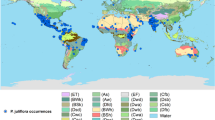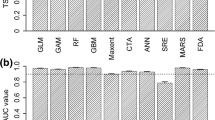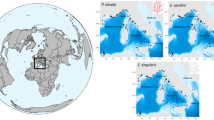Abstract
In an effort to predict the impact of climate change on the distribution of existing invasive species, niche-based models (NBMs) are being increasingly used to make forecasts. Here, we investigate the reliability of these models in predicting future climatic suitability for 4 invasive decapods of the Iberian Peninsula: Cherax destructor, Eriocheir sinensis, Pacifastacus leniusculus and Procambarus clarkii. From an ensemble of forecasts generated by 5 distinct algorithms (generalized linear models, artificial neural networks, support vector machines, random forests and alternating decision trees), we calculated consensus predictions for current conditions and 3 future time periods (2030, 2050 and 2080) under low and high scenarios of greenhouse gas emissions. Three criteria were examined to infer the robustness of the forecasts: ability to predict current distributions, inter-model variability and degree of environmental extrapolation. Our results indicate an overall decline in climatic suitability for the 4 invaders as time progresses. However, we also identified highly distinct levels of predictive uncertainty among species. Good indicators of reliability were found for Procambarus clarkii and Pacifastacus leniusculus, whereas the predictions for C. destructor showed low predictive performance, low inter-model agreement and wide areas of environmental extrapolation. For E. sinensis, the models also showed high variability with respect to areas projected to lose climatic suitability. Overall, our results highlight the need to consider and evaluate multiple sources of uncertainty when using NBM predictions for invaders under current and future conditions.




Similar content being viewed by others
References
Anastácio PM, Parente VS, Correia AM (2005) Crayfish effects on seeds and seedlings: identification and quantification of damage. Freshw Biol 50:697–704
Araújo MB, New M (2007) Ensemble forecasting of species distributions. Trends Ecol Evol 22:42–47
Araújo MB, Rahbek C (2006) How does climate change affect biodiversity? Science 313:1396
Arce JA, Alonso F (2011) Factors related to the presence of the Austropotamobius pallipes (Lereboullet, 1858) species complex in calcareous mountin rivers in central Spain. Knowl Manag Aquat Ecosyst 401:25
Austin MP, Van Niel KP (2011) Improving species distribution models for climate change studies: variable selection and scale. J Biogeogr 38:1–8
Beatty SJ (2006) The diet and trophic positions of translocated, sympatric populations of Cherax destructor and Cherax cainii in the Hutt River, Western Australia: evidence of resource overlap. Marine Freshw Res 57:825–835
Beaumont LJ, Hughes L, Pitman AJ (2008) Why is the choice of future climate scenarios for species distribution modelling important? Ecol Lett 11:1135–1146
Beaumont LJ, Gallagher RV, Downey PO et al (2009a) Modelling the impact of Hieracium spp. on protected areas in Australia under future climates. Ecography 32:757–764
Beaumont LJ, Gallagher RV, Thuiller W et al (2009b) Different climatic envelopes among invasive populations may lead to underestimations of current and future biological invasions. Divers Distrib 15:409–420
Bernardo JM, Costa AM, Bruxelas S et al (2011) Dispersal and coexistence of two non-native crayfish species (Pacifastacus leniusculus and Procambarus clarkii) in NE Portugal over a 10-year period. Knowl Manag Aquat Ecosyst 401:28
Breiman L (2001) Random forests. Mach Learn 45:5–32
Broennimann O, Guisan A (2008) Predicting current and future biological invasions: both native and invaded ranges matter. Biol Lett 4:585–589
Brotons L, Thuiller W, Araújo MB et al (2004) Presence-absence versus presence-only modelling methods for predicting bird habitat suitability. Ecography 27:437–448
Buisson L, Thuiller W, Casajus N et al (2010) Uncertainty in ensemble forecasting of species distribution. Glob Change Biol 16:1145–1157
Cabral H, Costa M (1999) On the occurrence of the Chinese mitten crab, Eriocheir sinensis in Portugal (Decapoda, Brachyura). Crustaceana 72:55–58
Caissie D (2006) The thermal regime of rivers: a review. Freshw Biol 51:1389–1406
Capinha C, Anastácio P (2011) Assessing the environmental requirements of invaders using ensembles of distribution models. Divers Distrib 17:13–24
Capinha C, Leung B, Anastácio P (2011) Predicting worldwide invasiveness for four major problematic decapods: an evaluation of using different calibration sets. Ecography 34:448–459
Clavero M, Prenda J, Delibes M (2003) Trophic diversity of the otter (Lutra lutra L.) in temperate and Mediterranean freshwater habitats. J Biogeogr 30:761–769
Diniz-Filho JAF, Mauricio Bini L, Fernando Rangel T et al (2009) Partitioning and mapping uncertainties in ensembles of forecasts of species turnover under climate change. Ecography 32:897–906
Diniz-Filho JAF, Nabout JC, Bini LM et al (2010) Ensemble forecasting shifts in climatically suitable areas for Tropidacris cristata (Orthoptera: Acridoidea: Romaleidae). Insect Conserv Divers 3:213–221
Dittel AI, Epifanio CE (2009) Invasion biology of the Chinese mitten crab Eriochier sinensis: a brief review. J Exp Marine Biol Ecol 374:79–92
Dormann C (2007) Promising the future? Global change projections of species distributions. Basic Appl Ecol 8:387–397
Dormann CF, Purschke O, Márquez JRG et al (2008) Components of uncertainty in species distribution analysis: a case study of the great grey shrike. Ecology 89:3371–3386
Drake JA (2009) Handbook of alien species in Europe. Springer, Dordrecht
Drake JM, Randin C, Guisan A (2006) Modelling ecological niches with support vector machines. J Appl Ecol 43:424–432
Dukes J, Mooney H (1999) Does global change increase the success of biological invaders? Trends Ecol Evol 14:135–139
Elith J, Graham CH (2009) Do they? How do they? WHY do they differ? On finding reasons for differing performances of species distribution models. Ecography 32:66–77
Elith J, Leathwick J (2009) Species distribution models: ecological explanation and prediction across space and time. Annu Rev Ecol Evol Syst 40:677–697
Elith J, Graham C, Anderson R et al (2006) Novel methods improve prediction of species distributions from occurrence data. Ecography 29:129–151
Elith J, Kearney M, Phillips S (2010) The art of modelling range-shifting species. Methods Ecol Evol 1:330–342
Ficetola GF, Thuiller W, Padoa-Schioppa E (2009) From introduction to the establishment of alien species: bioclimatic differences between presence and reproduction localities in the slider turtle. Divers Distrib 15:108–116
Fitzpatrick M, Hargrove W (2009) The projection of species distribution models and the problem of non-analog climate. Biodivers Conserv 18:2255–2261
Freund Y, Mason L (1999) The alternating decision tree learning algorithm. In: Proceeding of the sixteenth international conference on machine learning. Bled, pp 124–133
Galil BS, Nehring S, Panov V (2007) Waterways as invasion highways—impact of climate change and globalization. In: Nentwig W (ed) Biological invasions. Springer, Berlin, pp 59–74
Gallagher R, Hughes L, Leishman M et al (2010) Predicted impact of exotic vines on an endangered ecological community under future climate change. Biol Invasions 12:4049–4063
Garcia-de-Lomas J, Dana E, López-Santiago J et al (2010) Management of the Chinese mitten crab, Eriocheir sinensis (H. Milne Edwards, 1853) in the Guadalquivir Estuary (Southern Spain). Aquat Invasions 5:323–330
Grenouillet G, Buisson L, Casajus N et al (2011) Ensemble modelling of species distribution: the effects of geographical and environmental ranges. Ecography 34:9–17
Guisan A, Thuiller W (2005) Predicting species distribution: offering more than simple habitat models. Ecol Lett 8:993–1009
Guisan A, Zimmermann NE (2000) Predictive habitat distribution models in ecology. Ecol Model 135:147–186
Gutiérrez-Yurrita P, Martinez J, Bravo-Utrera M et al. (1999) The status of crayfish populations in Spain and Portugal. In: Gherardi F, Holdich DM (eds) Crayfish in Europe as alien species. How to make the best of a bad situation? A.A. Balkema, Rotterdam, pp 161–192
Hall M, Frank E, Holmes G et al (2009) The WEKA data mining software: an update. SIGKDD Explor Newsl 11:10–18
Hanley J, McNeil B (1982) The meaning and use of the area under a receiver operating characteristic (ROC) curve. Radiology 143:29–36
Hartley S, Harris R, Lester PJ (2006) Quantifying uncertainty in the potential distribution of an invasive species: climate and the Argentine ant. Ecol Lett 9:1068–1079
Hellmann J, Byers J, Bierwagen B et al (2008) Five potential consequences of climate change for invasive species. Conserv Biol 22:534–543
Holdich DM (2002) Distribution of crayfish in Europe and some adjoining countries. Bull Fr Pêche Piscic 367:611–650
Holdich D, Reynolds J, Souty-Grosset C et al (2009) A review of the ever increasing threat to European crayfish from non-indigenous crayfish species. Knowl Manag Aquat Ecosyst 394–395:11
Ilhéu M, Bernardo J, Fernandes S (2007) Predation of invasive crayfish on aquatic vertebrates: the effect of Procambarus clarkii on fish assemblages in Mediterranean temporary streams. In: Gherardi F (ed) Biological invaders in inland waters: profiles, distribution, and threats. Springer, Netherlands, pp 543–558
IPCC (2007) Climate change 2007: the physical science basis. Contribution of Working Group I to the Fourth Assessment Report of the Intergovernmental Panel on Climate Change. Cambridge University Press, Cambridge
Jones PG, Thornton PK, Heinke J (2009) Generating characteristic daily weather data using downscaled climate model data from the IPCC’s Fourth Assessment. https://hc.box.net/shared/f2gk053td8. Accessed 15 Feb 2011
Kearney M, Porter W (2009) Mechanistic niche modelling: combining physiological and spatial data to predict species’ ranges. Ecol Lett 12:334–350
Lavergne S, Molofsky J (2007) Increased genetic variation and evolutionary potential drive the success of an invasive grass. Proc Natl Acad Sci USA 104:3883–3888
Le Lay G, Engler R, Franc E et al (2010) Prospective sampling based on model ensembles improves the detection of rare species. Ecography 33:1015–1027
Liu C, Berry PM, Dawson TP et al (2005) Selecting thresholds of occurrence in the prediction of species distributions. Ecography 28:385–393
Lynas J, Storey A, Knott B (2007) Introduction and spread of crayfish (Parastacidae) in Western Australia and their potential to displace indigenous species. In: Gherardi F (ed) Biological invaders in inland waters: profiles, distribution, and threats. Springer, Netherlands, pp 577–596
Mateo RG, Croat TB, Felicísimo ÁM et al (2010) Profile or group discriminative techniques? Generating reliable species distribution models using pseudo-absences and target-group absences from natural history collections. Divers Distrib 16:84–94
McCullagh P, Nelder J (1989) Generalized linear models, 2nd edn. Chapman and Hall, London
Nakicenovic N, Swart R (2000) Emissions scenarios. A special report of Working Group III of the Intergovernmental Panel on Climate Change. Cambridge University Press, Cambridge
Newbold T (2010) Applications and limitations of museum data for conservation and ecology, with particular attention to species distribution models. Prog Phys Geogr 34:3–22
Nyström P (2002) Ecology. In: Holdich DM (ed) Biology of freshwater crayfish. Blackwell Science, Oxford, pp 192–235
Pearman PB, Guisan A, Broennimann O et al (2008) Niche dynamics in space and time. Trends Ecol Evol 23:149–158
Pearson R, Thuiller W, Araújo M et al (2006) Model-based uncertainty in species range prediction. J Biogeogr 33:1704–1711
Peterson AT (2003) Predicting the geography of species’ invasions via ecological niche modeling. Q Rev Biol 78:419–433
Peterson AT, Papeş M, Eaton M (2007) Transferability and model evaluation in ecological niche modeling: a comparison of GARP and Maxent. Ecography 30:550–560
Pfahringer B, Holmes G, Kirkby R (2001) Optimizing the induction of alternating decision trees. In: Cheung D, Williams G, Li Q (eds) Advances in knowledge discovery and data mining. Springer, Berlin, pp 477–487
Phillips SJ (2008) Transferability, sample selection bias and background data in presence-only modelling: a response to Peterson et al. (2007). Ecography 31:272–278
Phillips SJ, Anderson RP, Schapire RE (2006) Maximum entropy modeling of species geographic distributions. Ecol Model 190:231–259
Rahel F, Olden J (2008) Assessing the effects of climate change on aquatic invasive species. Conserv Biol 22:521–533
Rahmstorf S, Cazenave A, Church JA et al (2007) Recent climate observations compared to projections. Science 316:709
Roura-Pascual N, Brotons L, Peterson A et al (2009) Consensual predictions of potential distributional areas for invasive species: a case study of Argentine ants in the Iberian Peninsula. Biol Invasions 11:1017–1031
Rudnick DA, Hieb K, Grimmer KF et al (2003) Patterns and processes of biological invasion: the Chinese mitten crab in San Francisco Bay. Basic Appl Ecol 4:249–262
Sabater S, Feio MJ, Graça MAS et al (2009) Chapter 4—The Iberian Rivers. In: Tockner K, Uehlinger U, Robinson CT (eds) Rivers of Europe. Academic Press, London, pp 113–149
Sahlin U, Smith HG, Edsman L et al (2010) Time to establishment success for introduced signal crayfish in Sweden—a statistical evaluation when success is partially known. J App Ecol 47:1044–1052
Sarle W (1994) Neural networks and statistical models. In: Proceedings of the nineteenth annual SAS users groups international conference. SAS Institute Inc., Cary, pp 1538–1550
Souty-Grosset C, Holdich DM, Noël PY et al (2006) Atlas of crayfish in Europe. Muséum National d’Histoire Naturelle, Paris
Thuiller W, Brotons L, Araújo MB et al (2004) Effects of restricting environmental range of data to project current and future species distributions. Ecography 27:165–172
Thuiller W, Richardson D, Pysek P et al (2005) Niche-based modelling as a tool for predicting the risk of alien plant invasions at a global scale. Glob Change Biol 11:2234–2250
VanDerWal J, Shoo LP, Graham C et al (2009) Selecting pseudo-absence data for presence-only distribution modeling: how far should you stray from what you know? Ecol Model 220:589–594
Vapnik VN (1995) The nature of statistical learning theory. Springer, New York
Vose R, Easterling D, Gleason B (2005) Maximum and minimum temperature trends for the globe: an update through 2004. Geophys Res Lett 32:L23822
Walther G, Roques A, Hulme P et al (2009) Alien species in a warmer world: risks and opportunities. Trends Ecol Evol 24:686–693
Acknowledgments
We thank the many researchers and institutions that provided species distribution data. We are also grateful to the associate Editor and 2 anonymous reviewers for helpful comments on the manuscript. This research work benefited from the DID (Dispersal of Invasive Decapoda) (PTDC/BIA-BEC/105182/2008) research project co-financed by the Portuguese Fundação para a Ciência e Tecnologia (FCT), and the European Union programs COMPETE, QREN and FEDER. C.C. holds a PhD grant from FCT (SFRH/BD/41129/2007).
Author information
Authors and Affiliations
Corresponding author
Electronic supplementary material
Below is the link to the electronic supplementary material.
Rights and permissions
About this article
Cite this article
Capinha, C., Anastácio, P. & Tenedório, J.A. Predicting the impact of climate change on the invasive decapods of the Iberian inland waters: an assessment of reliability. Biol Invasions 14, 1737–1751 (2012). https://doi.org/10.1007/s10530-012-0187-z
Received:
Accepted:
Published:
Issue Date:
DOI: https://doi.org/10.1007/s10530-012-0187-z




